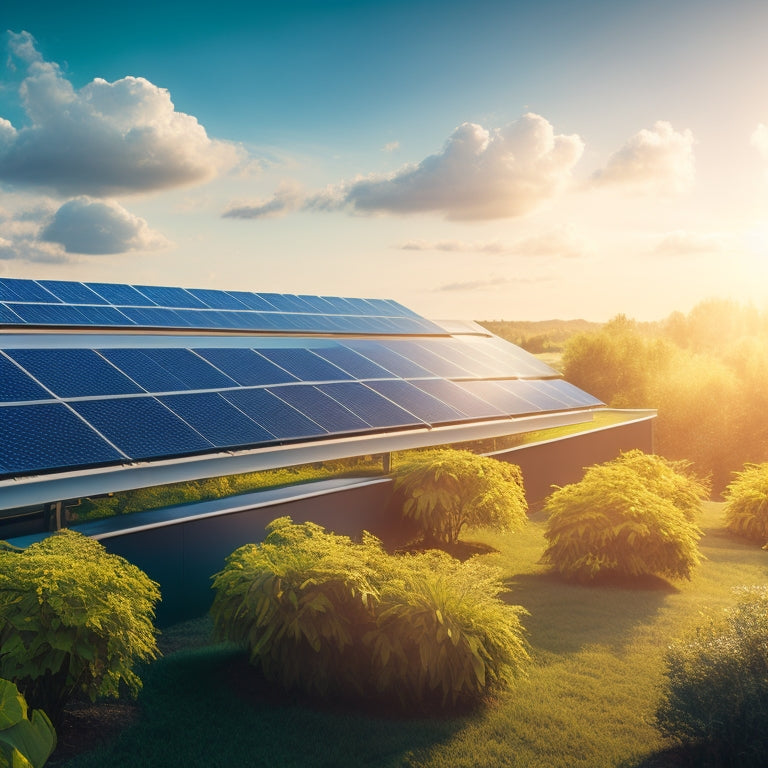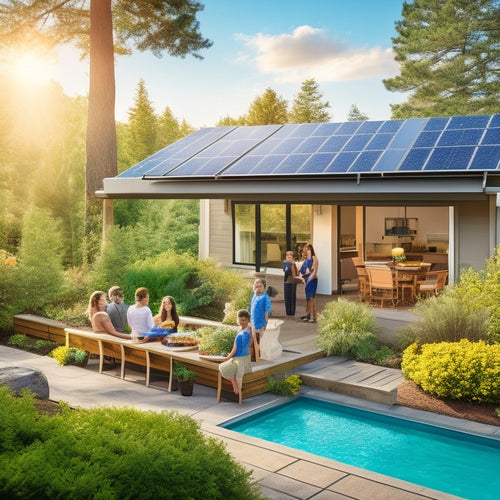
Expectations From High Efficiency Solar Panels in 2024
Share
In 2024, you can expect high efficiency solar panels to drastically cut your energy bills and enhance energy output even in less than ideal conditions. With advancements in cell technology and innovative cooling systems, these panels can increase efficiency by up to 25%. Their durability has improved, allowing them to perform well under extreme temperatures. You'll also find financial incentives, like tax credits and grants, making the upfront investment more manageable. By evaluating your energy needs, you can maximize this technology's potential. Uncovering further details could set you up for an even smarter solar investment.
At a Glance
- Homeowners can expect a payback period of 5 to 7 years, resulting in significantly reduced or virtually free electricity thereafter.
- Advanced cell technology is projected to enhance energy output efficiency by up to 25%, even in adverse weather conditions.
- Government incentives and local state programs will continue to lower upfront costs, making solar investments more accessible to homeowners.
- Solar panels will increasingly perform well in extreme temperatures, maintaining efficiency and reliability in both heat and cold.
- The growing demand for renewable energy solutions will drive innovation in materials, improving durability and sustainability of solar panels.
Cost-Effective Long-Term Investment
Investing in high efficiency solar panels can greatly reduce your energy bills over time, allowing you to recoup your initial investment.
With advancements in advanced technologies enhancing energy conversion rates, many homeowners can expect even greater savings.
Additionally, various government incentives are available that can further offset costs, making this a financially savvy choice for many homeowners.
Reduced Energy Bills
Switching to high efficiency solar panels in 2024 can considerably reduce your energy bills, making it a smart choice for homeowners looking for long-term savings.
With advancements in technology, these panels convert sunlight into electricity more effectively, resulting in greater energy savings over time. Research indicates that homeowners can expect a reduction of up to 50% in their monthly energy costs, providing substantial financial relief.
By utilizing solar power, you're not just cutting expenses; you're also insulating yourself against rising energy prices. Traditional energy sources have seen consistent price increases, while solar energy offers a stable and predictable cost structure.
In fact, studies show that the average payback period for high efficiency solar panels is around five to seven years, after which you'll benefit from virtually free electricity.
Moreover, the increasing efficiency of these panels means you can generate more power even in less-than-ideal weather conditions, maximizing your savings.
As you invest in high efficiency solar panels, you're not just making a financial choice; you're embracing a path to energy independence, ensuring that your home remains a sanctuary of freedom from escalating utility costs.
Government Incentives Available
As you examine high efficiency solar panels, it's important to contemplate the government incentives available, which can greatly enhance your cost-effectiveness. Federal rebates and tax credits are among the most significant benefits you can utilize. Currently, you might be eligible for a federal tax credit that covers a substantial percentage of your installation costs, effectively lowering your upfront investment.
Additionally, many states offer programs that provide solar grants and installation subsidies, making it easier for you to shift to renewable energy. By researching local state programs, you could find financing options, such as energy loans, that come with favorable terms, allowing you to spread your costs over time without compromising your budget.
These renewable incentives are designed to reduce financial barriers and equip you in your pursuit of energy independence. By taking advantage of these government incentives, you position yourself not just as a consumer, but as a proactive participant in the renewable energy movement.
Increased Energy Output Efficiency
As you investigate the advancements in solar technology, you'll see that advanced cell technology greatly increases energy output efficiency.
This innovation not only enhances performance under various environmental conditions but also maximizes the energy harvested from sunlight, aligning with the trend towards high-efficiency solar panels that typically exceed 20% efficiency ratings.
Advanced Cell Technology
Innovatively, advanced cell technology has emerged as a game changer in enhancing the energy output efficiency of solar panels in 2024. With significant advancements in cell efficiency, you're seeing a marked increase in energy conversion rates, directly impacting the effectiveness of solar energy systems.
Research breakthroughs in material innovations, like perovskite and multi-junction cells, have altered how solar panels capture sunlight, allowing for higher performance metrics under various conditions.
Furthermore, improvements in manufacturing processes have streamlined production, lowering costs while maintaining high quality. These design improvements enable more efficient layouts and configurations, maximizing surface area exposure to sunlight.
As you investigate these developments, you'll find that the integration of state-of-the-art technologies not only elevates overall efficiency but also enhances the sustainability of solar panel production.
The combination of these factors makes advanced cell technology a crucial element in the solar energy arena. In 2024, you can expect to see solar panels that aren't only more efficient but also more accessible, enabling users to capture renewable energy with greater freedom and effectiveness than ever before.
Enhanced Performance Under Conditions
Solar panels in 2024 are engineered to excel even in challenging environmental conditions, noticeably enhancing energy output efficiency. These advancements are essential for utilizing solar energy, especially in regions where temperature fluctuations can impede performance.
With improved temperature resilience, these panels maintain peak functionality in extreme heat or cold, ensuring you maximize energy production year-round.
Moreover, innovative materials and designs have greatly improved light absorption capabilities. By refining the interaction between sunlight and panel surface, manufacturers are enabling higher energy conversion rates.
This means you can expect more energy output, even during overcast days or low-light conditions, providing you with a dependable energy source.
Data indicates that panels designed with enhanced temperature resilience and superior light absorption can increase overall efficiency by up to 25%.
This leap in performance allows you to reduce reliance on conventional energy sources, equipping your path toward energy independence.
In 2024, embracing high-efficiency solar panels isn't just about sustainability; it's about taking control of your energy future, enjoying the freedom that comes with reliable, renewable energy customized to withstand the elements.
Innovative Cooling Technology
Innovative cooling technology plays an essential role in enhancing heat dissipation in solar panels, which directly impacts their energy output.
By effectively managing temperature, these systems allow for peak performance even in high-temperature conditions. This is particularly important as higher temperatures can reduce solar panel efficiency.
Consequently, you can expect a significant increase in energy efficiency and overall power generation from high-efficiency solar panels in 2024.
Enhanced Heat Dissipation
As temperatures rise, the efficiency of solar panels can markedly decline, impacting energy output. Effective thermal management is critical in addressing this challenge. Enhanced heat dissipation technologies have emerged as essential solutions to maintain peak performance.
By integrating advanced materials and innovative designs, manufacturers can improve heat resistance, ensuring panels operate efficiently even under extreme conditions.
For instance, the use of phase change materials (PCMs) can absorb excess heat during peak sunlight hours. This not only stabilizes temperatures but can also prolong the lifespan of solar panels by reducing thermal stress.
Additionally, incorporating micro-channel cooling systems allows for more efficient heat transfer, effectively lowering the surface temperature of the panels.
Data shows that implementing these technologies can lead to a significant increase in energy output, particularly in hot climates where traditional panels struggle.
With the demand for renewable energy sources soaring, investing in enhanced heat dissipation could be your key to utilizing solar power more effectively.
As you consider your energy independence, understanding the role of innovative cooling technology will enable you to make informed decisions for a sustainable future.
Improved Energy Output
The integration of advanced cooling technologies is changing how we can maximize energy output from solar panels. As solar panels heat up, their efficiency typically declines, limiting your energy harvest. However, innovative cooling solutions, like passive and active cooling systems, can maintain ideal temperatures, ensuring that you get the most from your investment.
By employing these technologies, you can expect energy output improvements of up to 20%, essential in an environment where sustainability trends are gaining momentum.
This enhanced performance isn't just about efficiency; it also positions you competitively in the market. As solar energy becomes a more pressing necessity due to climate change, those who adopt these cooling technologies can differentiate themselves from competitors. You're not just riding the wave of innovation; you're actively shaping the future of solar energy.
Moreover, these technologies align with broader sustainability goals, allowing you to contribute positively to the environment while reaping financial rewards. In a world increasingly focused on sustainable practices, embracing improved energy output through innovative cooling will enable you, letting you utilize the sun more effectively than ever before.
Selecting Based on Energy Needs
To choose the right solar panels, you need to start by evaluating your household's current energy consumption.
Conducting energy audits can help identify high usage areas and potential efficiency improvements, which are essential for optimizing your renewable system.
Analyzing your usage patterns will help you project future energy needs, especially as your household may evolve over time.
This data-driven approach guarantees that your solar investment aligns with both present and anticipated energy requirements, allowing for a more accurate sizing of your solar panel array based on total energy consumption.
Assessing Household Consumption
When evaluating your household's energy needs, it's essential to take a close look at consumption patterns. Understanding your energy consumption allows you to identify high-use appliances and peak usage times, helping you make informed decisions about solar panel installations.
Begin by tracking your household habits—note how often you use devices such as refrigerators, washing machines, and entertainment systems.
Gather data from your utility bills over the past year, focusing on monthly usage trends. This will reveal seasonal variations and highlight areas where you can improve efficiency. For instance, if you notice spikes during summer months, consider how air conditioning impacts your energy consumption.
Once you've assessed your patterns, you can estimate the size of the solar panel system that meets your needs. Remember, the goal is to align your solar energy production with your consumption, minimizing reliance on the grid.
Future Energy Projections
As you look ahead to your energy needs, understanding future energy projections is crucial for making informed decisions about your solar panel investment. The global shift toward sustainability trends highlights a growing demand for renewable energy solutions. By 2024, it's projected that residential energy consumption will increasingly rely on solar, driven by favorable renewable policies aimed at reducing carbon footprints.
Current data indicates that solar energy capacity could rise by over 30% in the next few years, thanks to advancements in technology and cost reductions. This means that investing in high-efficiency solar panels now can position you to capitalize on this growth.
Furthermore, government incentives and tax breaks will likely continue to encourage homeowners to shift to solar energy, further enhancing your financial freedom.
As you consider your energy future, factor in not just your immediate needs, but also potential increases in energy consumption due to electric vehicle integration and smart home technologies.
The projections indicate a clear pathway toward a more autonomous, renewable-powered lifestyle. Aligning your solar investment with these trends guarantees that you remain ahead of the curve, securing both sustainability and energy independence.
Higher Durability and Lifespan
As you investigate the advancements in solar panel technology, you'll notice that enhanced material technology is markedly improving durability and lifespan.
Research shows that new composites and coatings can withstand harsh environmental conditions, reducing the need for frequent replacements.
This means you can expect your investment to last longer, ultimately yielding better returns over time.
Enhanced Material Technology
In 2024, advancements in enhanced material technology greatly improve the durability and lifespan of solar panels. These material advancements focus on using innovative composites that not only elevate performance but also reduce the environmental impact associated with traditional materials. By utilizing sustainable resources, manufacturers are developing solar panels that withstand extreme weather conditions while maintaining efficiency.
You'll find that the integration of state-of-the-art recycling methods into the production process is also gaining traction. This commitment to sustainability aligns with rigorous industry standards, ensuring that panels are designed for a longer lifecycle.
Performance testing of these advanced materials reveals that they exceed previous benchmarks, offering greater application versatility in diverse environments.
Moreover, the emphasis on manufacturing efficiencies reduces waste and supports the circular economy. Lifecycle analysis shows that the new materials contribute not only to reduced carbon footprints but also to improved energy outputs over time.
As you consider your options for solar energy, these enhanced technologies promise not just higher durability and lifespan but also a more environmentally responsible choice, enabling you to adopt renewable energy with confidence.
Frequently Asked Questions
How Do High Efficiency Solar Panels Impact Property Value?
High efficiency solar panels enhance property value through improved property appreciation and significant energy savings. As you invest in sustainability, potential buyers recognize these benefits, leading to a desirable home that stands out in the market.
Are There Government Incentives for Installing High Efficiency Solar Panels in 2024?
Yes, there're federal tax credits and state rebates available for installing high efficiency solar panels. These incentives considerably reduce your upfront costs, enabling you to invest in clean energy while enhancing your property's value and sustainability.
What Are Common Maintenance Requirements for These Solar Panels?
Did you know that regular maintenance can enhance solar panel efficiency by up to 30%? You'll need effective cleaning techniques and consistent performance monitoring to guarantee peak output and longevity of your high-efficiency solar panels.
Can High Efficiency Solar Panels Work in Cloudy Climates?
Yes, high-efficiency solar panels can still generate energy in cloudy climates. While cloud coverage may reduce energy yield, these panels often perform better under such conditions, maximizing your energy independence even when sunlight isn't ideal.
How Do High Efficiency Panels Compare to Traditional Panels in Performance?
High efficiency panels outperform traditional ones in key performance metrics. They produce greater energy output, especially in varied conditions, maximizing your investment and providing you with more freedom to utilize renewable energy effectively.
Explore More
As you consider investing in high-efficiency solar panels in 2024, remember that while upfront costs might seem intimidating, the long-term savings and energy output can greatly outweigh those initial expenses. With advancements in cooling technology and durability, these panels not only meet your energy needs but also promise longevity. Don't let concerns about price deter you; instead, focus on the considerable returns that come with a smart, data-driven investment in solar energy.
Related Posts
-

Solar Phone Chargers for Camping Essentials
Solar phone chargers are must-haves for your camping essentials, allowing you to stay connected while enjoying nature...
-

Top-Rated Home Solar Power Kits for Achieving Energy Independence
Top-rated home solar power kits enable you to achieve energy independence by greatly cutting your energy costs. You c...
-

High-Efficiency Solar Battery Chargers for Remote Areas
High-efficiency solar battery chargers are essential for your off-grid energy needs in remote areas. They maximize en...


